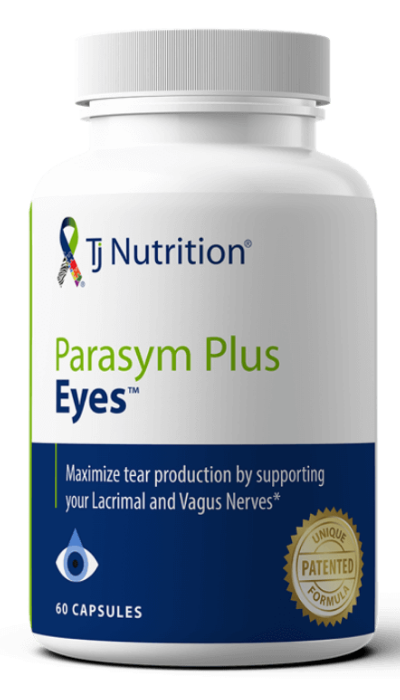Our eyes, just like each of our body’s other systems, need the right combination of vitamins and minerals to function properly. If you’re suffering from chronic dry eye, supplementation with key antioxidants, omega-3’s, and Vitamin A, and even specialty supplements may help to support tear production and ocular function.
Parasym Plus Eyes™ – Systemic Treatment in a Patented Supplement
Parasym Plus Eyes™ is a new and completely unique approach to dry eye treatment. This is the only treatment that addresses chronic dry eye as more than just an eye problem.
A new research breakthrough indicates that patients with dry eye disease (DED) have other symptoms that hint at a systemic contribution to the dry eye symptoms. Dry eye disease may not be just “an eye problem”.
Patients with chronic DED often experience symptoms such as fatigue, mental fatigue or “brain fog”, sluggish digestion, constipation, mood swings, large pupils with light sensitivity, and even depression and anxiety, in addition to dry eyes.
It can be easy to blame these subtle symptoms on “getting older”, a poor diet, or “just being stressed”. But when seen as a pattern, this may reflect low acetylcholine release (an important neurotransmitter) not only resulting in low tear production, but also affecting the body in other ways. When this happens, patients may not feel their best, but recognizing it and treating it at its source, results in dramatic improvement in dry eye symptoms in addition to increased wellness and energy.
Acetylcholine is a neurotransmitter utilized by the parasympathetic nervous system. This is the rest and digest system of the body that allows normal digestion, heart rate, and breathing, bowel movements, and interestingly, tear production. Acetylcholine is also utilized by the brain, the central nervous system, for cognition, sharp thinking and short term memory.
When not released properly, dry eyes result, in addition to some of these additional symptoms of low acetylcholine.
Acetylcholine is used by the parasympathetic nerves that allow us to produce basal tears. It is also used by the vagus nerve — this nerve is the anti-inflammatory nerve of the body. Much of dry eye disease is inflammatory. Acetylcholine release diminishes with age, inflammation, with some medications, and genetic disorders. Parasym Plus Eyes works despite the reason for its diminished release.
Parasym Plus Eyes™ is a new, patented compound that supports acetylcholine for tear production and to control inflammation. By supporting the vagus nerve, it also allows normal bowel movements and digestion. It also crosses the blood-brain barrier to maximize cognition.
Despite the reason for low acetylcholine release, Parasym Plus Eyes™ will work because it works directly on the receptors on the nerves. It doesn’t rely on intact nerves, nor stimulation of the nerves.
This is a revolutionary concept whose time has come! There is no drug that will do this. I recommend that patients take this the first thing in the morning, preferably on a basically empty stomach. If your pupils are large, they should normalize within about three days. When that happens, you know you are on your way! If you struggle with constipation, you may get relief within an hour or two. Tear production increases and dry eye symptoms are usually dramatically improved within a month or so.
You should not discontinue doing what your doctor has you doing for your dry eyes, but just roll this into your treatment regimen. Then watch for not only resolution of dry eye symptoms, but increased wellness and energy as well.
Watch your bowel movements, digestion, cognition, and energy level along with your tear production. It’s a new concept for most of us. But when you appreciate all this is doing for you, you will wonder how you did without it!
Patented Parasym Plus Eyes™ is the only compound scientifically proven to nudge the lacrimal and vagus nerves to safely support normal tear production.
For more information, follow the links below:
Parasym Plus Eyes™ – Product Information Page
- https://vagusnervesupport.com/dry-eye-disease/ – Research paper
-
Optometric Management, The Journey to Neurological Dry Eye Disease November 2021 https://www.optometricmanagement.com/news/2021/online-exclusive-in-a-spot-with-pots
-
Review of Optometry, December 2021 Neurological DED Management in Action by Paul Karpecki, OD and Diana Driscoll, OD
-
Primary Care Optometry News, December 2021 Supplement Targets Dry Eye Disease Through Nerve Function
-
https://ois.net/calculating-both-sides-of-the-doctor-patient-equation-with-diana-driscoll-od/
-
https://dryeyecoach.com/podcast/is-dry-eye-disease-a-systemic-problem-an-eye-doctors-journey/
Antioxidants
Antioxidants are a class of natural or human-made substances that can, in some cases, prevent or delay cell damage.1 Antioxidants limit the formation of free radicals, the process of oxidation, and the onset of oxidative stress.
Because oxidative stress is a major cause of inflammation, antioxidants are credited with controlling inflammation.
Here at Dry Eye Recovery, we count ourselves among the “many who hypothesize that the [cause] of dry eye is often, by nature, inflammatory.”2
The Effect of Antioxidants on Dry Eye & Ocular Diseases
In 2009, the European Journal of Ophthalmology conducted a trial to study the potential effects of antioxidant supplementation on dry eye symptoms. Researchers concluded that:
“Supplementation with oral antioxidants can improve both tear stability and quantity, but also subjective clinical signs.”3
The participants, all dry eye patients, reported improvement in symptoms characterized as “burning,” “itching,” and “redness,” as well as “sensations of foreign body in the eye.”3
Subsequent clinical trials and large-scale longitudinal studies have linked certain antioxidants to positive treatment outcomes for macular degeneration, an eye disease that causes permanent vision loss in people over 60.4,5,6
Certainly, antioxidants are involved in ocular health. Fortunately, they are everywhere.
Well-known antioxidants2 include:
- Vitamins C and E
- Selenium
- Carotenoids
- Lycopene
- Lutein
- Zeaxanthin
Dietary Sources of Antioxidants
Vegetables, fruits, and nuts are all good sources of antioxidants. That means adding more foods like leafy greens, red fruits, berries, citrus fruits, and pecans to one’s diet. (Remember, though, that healthy fruits are still high in sugar, and healthy nuts are still a source of fat.)
For Dry Eye Patients, Supplementation is a Necessity
While diets high in vegetables and fruits are essential for general health, we always recommend targeted antioxidant supplementation.
Why? Because antioxidants are too broad a class of substances for the average person to include in their diet.
Antioxidant Supplements We Recommend
- BRI Spirulina 2000mg Maximum Strength Premium Quality Spirulina Superfood Powder
- PreserVision AREDS 2 Eye Vitamin & Mineral Supplement
- Solgar Vitamin E 268 mg (400 IU), 360 Alpha Softgels
- Beta Balance NAC MAX™
Omega-3 Fatty Acids
Omega-3 fatty acids have a great record of efficacy for a wide range of dry eye symptoms.
A review of literature released in 2016 concluded, “Omega-3 fatty acids, especially DHA, have been found to improve DES [dry eye syndrome] in randomized clinical trials.”7
A History of Promising Outcomes
Looking specifically at oral supplementation of Omega-3 fatty acids (O3FAs), there are already too many positive outcomes and trials to discuss each one in detail. Below is a short overview of oral O3FA supplementation and its benefits for dry eye symptoms.
- Improved Dry Eye Symptoms in Meibomian Gland Dysfunction: O3FAs supplementation restored the quality and quantity of meibum, significantly decreased tear evaporation, and improved OSDI symptom scores in dry eye patients suffering from meibomian gland dysfunction (MGD).8,9
- Improved Tear Production in Rosacea Patients With Dry Eye: O3FAs dietary intervention and supplementation significantly improved common dry eye symptoms, evaporative dry eye, and tear production in rosacea patients with dry eye.10
- Reduced Ocular Inflammation: Oral consumption of O3FAs showed generalized anti-inflammatory effects as well as decreased inflammation on the surface of the eyes and eyelids of the participants.11 Participants reported suffering from moderate dry eye before the trial. So far as we know, there were no follow-ups.
- Helped Alleviate Symptoms of Computer Vision Syndrome Related Dry Eye: Researchers concluded that orally-administered O3FAs could alleviate dry eye symptoms, decrease rates of tear evaporation, and lower reported suffering for patients with dry eye related to excessive computer use.12
- Improved Dry Eye Symptoms for Contact Lens Wearers: Results from this study in the journal Cornea pointed to “benefits of orally administered O3FAs in alleviating dry eye symptoms, improving lens wear comfort, and cytological changes in contact lens wearers.”13
For Omega-3s, Add Fish & Fish Oil
For the most part, studies have singled out two omega-3’s as being especially helpful in supporting normal and healthy eye function— docosahexaenoic acid (DHA) and eicosapentaenoic acid (EPA). These fatty acids are abundant in fish oil.
Can you make progress by adding fish to your diet? Of course. However, we also recommend supplementing with fish oil. This way, it is possible to get plenty of O3FAs, eat the right amount of healthy fish, and avoid regularly ingesting low levels of mercury found in wild fish like salmon.
Omega-Fatty Acid Supplements We Recommend
- Nordic Naturals Omega-3, Lemon Flavor – 690 mg Omega-3-90 Soft Gels – Fish Oil – EPA & DHA – Immune Support, Brain & Heart Health, Optimal Wellness – Non-GMO – 45 Servings
- Nature’s Bounty Fish Oil, 2400mg, 1200mg of Omega-3, 90 Coated Softgels

Vitamin A
Vitamin A has a deep connection to eye health. For example, vitamin A provides the retina with melanin, a pigment essential for protecting the eye against infection and damage from ultraviolet rays.
Vitamin A is the chemical precursor of rhodopsin, which is responsible for vision in low-light conditions. The stability of the tear film’s three layers — oil, water, and mucin — can be attributed to Vitamin A. This effect on stability applies to healthy eyes and the eyes of patients with dry eye syndrome.
According to the journal Clinical Ophthalmology, “Oral vitamin A supplementation improves the quality, but not [sic] quantity, of tears in patients with dry eye.”14
Researchers ultimately found that oral vitamin A minimized the symptoms of dry eye due to its effect on the ocular tear film.
Dietary & Supplementary Sources of Vitamin A
Vitamin A supplementation of up to 5,000 IU may help with symptoms of dry eye. It is most effective as beta-carotene.15 Dry eye patients should feel free to add vitamin A through dietary sources, as well. These sources include but are not limited to:
- Eggs
- Spinach
- Carrots
- Sweet Potatoes
Vitamin A can be toxic at doses of more than 10,000 IU. But it’s important to distinguish between preformed Vitamin A and provitamin A.
Beta-carotene, a provitamin A, is far less likely to cause toxicity, simply because it must first be metabolized to form Vitamin A.16
Vitamin A Supplements We Recommend
References
1. Antioxidants: In Depth. National Center for Complementary and Integrative Health. https://www.nccih.nih.gov/health/antioxidants-in-depth. Accessed May 5, 2021. The authors elected to substitute “the cause” for “etiology.” This decision was made for the benefit of the average reader and the comprehension of general audiences.
2. Rand AL, Asbell PA. Nutritional supplements for dry eye syndrome. Curr Opin Ophthalmol. 2011;22(4):279-282. doi:10.1097/ICU.0b013e3283477d23
3. Drouault-Holowacz S, Bieuvelet S, Burckel A, et al. Antioxidants intake and dry eye syndrome: a crossover, placebo-controlled, randomized trial. Eur J Ophthalmol. 2009;19(3):337-342. doi:10.1177/112067210901900302
4. Al-Zamil WM, Yassin SA. Recent developments in age-related macular degeneration: a review. Clin Interv Aging. 2017;12:1313-1330. Published 2017 Aug 22. doi:10.2147/CIA.S143508
5. AREDS/AREDS2 Clinical Trials. National Eye Institute. https://www.nei.nih.gov/research/clinical-trials/age-related-eye-disease-studies-aredsareds2/about-areds-and-areds2#section-id-14213. Published November 19, 2020. Accessed May 4, 2021. AREDS/AREDS 2 Reports represent cumulative data from multiple reports published in different publications and authored by a range of different individuals. This is why authorship and publication information is not included in this citation.
6. Moriarty-Craige SE, Adkison J, Lynn M, et al. Antioxidant supplements prevent oxidation of cysteine/cystine redox in patients with age-related macular degeneration. Am J Ophthalmol. 2005;140(6):1020-1026. doi:10.1016/j.ajo.2005.06.043
7. McCusker MM, Durrani K, Payette MJ, Suchecki J. An eye on nutrition: The role of vitamins, essential fatty acids, and antioxidants in age-related macular degeneration, dry eye syndrome, and cataract. Clin Dermatol. 2016;34(2):276-285. doi:10.1016/j.clindermatol.2015.11.009
8. Bhargava R, Chandra M, Bansal U, Singh D, Ranjan S, Sharma S. A Randomized Controlled Trial of Omega 3 Fatty Acids in Rosacea Patients with Dry Eye Symptoms. Curr Eye Res. 2016;41(10):1274-1280. doi:10.3109/02713683.2015.112281
9. Epitropoulos AT, Donnenfeld ED, Shah ZA, et al. Effect of oral re-esterified omega-3 nutritional supplementation on dry eyes. Cornea. 2016;35(9):1185-91.
10. Liu Y, Kam WR, Sullivan DA. Influence of omega 3 and 6 fatty acids on human meibomian gland epithelial cells. Cornea. 2016;35(8):1122-6.
11. Gatell-Tortajada J. Oral supplementation with a nutraceutical formulation containing omega-3 fatty acids, vitamins, minerals, and antioxidants in a large series of patients with dry eye symptoms: results of a prospective study. Clin Interv Aging. 2016;11:571-578. Published 2016 May 19. doi:10.2147/CIA.S98102
12. Bhargava R, Kumar P, Phogat H, Kaur A, Kumar M. Oral omega-3 fatty acids treatment in computer vision syndrome related dry eye. Cont Lens Anterior Eye. 2015;38(3):206-210. doi:10.1016/j.clae.2015.01.007
13. Bhargava R, Kumar P. Oral omega-3 fatty acid treatment for dry eye in contact lens wearers. Cornea. 2015;34(4):413-420. doi:10.1097/ICO.0000000000000386
14. Alanazi SA, El-Hiti GA, Al-Baloud AA, et al. Effects of short-term oral vitamin A supplementation on the ocular tear film in patients with dry eye. Clin Ophthalmol. 2019;13:599-604. Published 2019 Apr 10. doi:10.2147/OPTH.S198349
15. Chea EP, Lopez MJ, Milstein H. Vitamin A. In: StatPearls. Treasure Island (FL): StatPearls Publishing; July 10, 2020. PMID: 29493984
16. Olson JM, Ameer MA, Goyal A. Vitamin A Toxicity. [Updated 2021 Feb 11]. In: StatPearls [Internet]. Treasure Island (FL): StatPearls Publishing; 2021 Jan-. Available from: https://www.ncbi.nlm.nih.gov/books/NBK532916/

